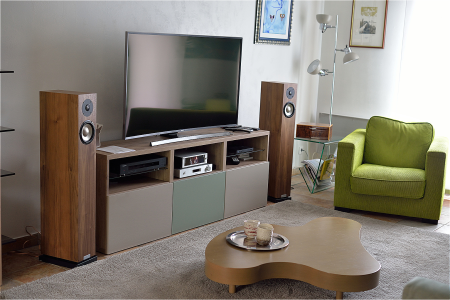Whatever the style of music, Recital-Audio loudspeakers are designed to provide a faithful and balanced listening experience in a ‘standard’ living room. However, there are some simple recommendations for optimising the listening room to allow you to explore the full potential of the speakers.
Impact of the room
Quite often neglected from the point of view of its acoustics, the listening room has a dominant effect on the final sound perception and must be considered as a part of the Hi-Fi system. In other words, poor room acoustics can significantly degrade the overall performance of a HIFI system.
As with a loudspeaker, all rooms have characteristics, or more accurately ‘room acoustics’, that influence tonal balance and soundstage.
But what do we mean by room acoustics ? All the dimensions, surfaces, shapes, materials, objects and furniture in your room contribute to creating a singular acoustic, more or less reverberant; the characteristics of this acoustic will depend on your perception of sounds and music.

Room optimization
An acoustic that is too reverberant will tend to degrade the sound image and accentuate certain frequencies (midrange, high-midrange) to the expense of the bass; this can make listening imprecise and aggressive. On the other hand, a room that is too much “muted” or “damped” will give an impression of suffocation, of flat sound, lacking in depth. To take advantage of the full potential of your hi-fi speakers, the acoustics of the listening room must therefore be neither too reverberant nor too unreverberant.
This recommendation is not only applicable to hi-fi listening, but also to everyday life; for example, a living room that is too reverberant will also have the effect of accentuating everyday noises and sounds in an unpleasant way.
In most cases, the acoustics of the room are too reverberant; this can be easily rectified by adding furniture, objects, plants and more or less absorbent materials. For instance:
- A carpet on a tiled or parquet floor, ideally placed between the listening point and the HIFI speakers, will increase the proportion of absorbent materials in your room and have the effect of attenuating the reverberations.
- Furniture and/or shelves with records, books and various decorative objects will help diffract and diffuse sound waves and reduce ping-pong or floating echo effects.
- For large glass surfaces, thick curtains and double curtains will play an important role in limiting the amplitude of direct reflections and accelerate the decay of reverberations.
Orientation
All speakers in our product line have a low and homogeneous directivity thanks to passive PM filtering. This feature ensures a balanced musical reproduction, even outside the usual listening position.
In fact, Recital-Audio loudspeakers can be positioned perpendicular to the rear wall, or pinched towards the listener, without this having a significant effect on tonal balance and on the perception of the musical scene.

Placement
Due to the size, furniture, materials, objects, decoration etc., all rooms have different acoustics; more or less reverberant, with their own resonances (standing waves).
There is therefore no strict rule that applies to all listening room/loudspeaker “configurations”. However, factors related to positioning modify the sound perception and allow, if necessary, to improve the listening quality of your loudspeakers;
Proximity of the speaker to the walls
The distance of the loudspeaker from the wall affects the perception of low frequencies at the listening point. Indeed, bringing the loudspeakers closer to the walls will increase the perceived level of the bass and low-midrange registers. On the other hand, a decrease in the amplitude of these same frequencies is felt when the speakers are moved away from the walls.
![Niveau-de-grave-en-fonction-du-positionnement[1]](https://www.recital-audio.com/wp-content/uploads/2020/07/Niveau-de-grave-en-fonction-du-positionnement1.jpg)
As a general rule, it is not advisable to position loudspeakers directly in a corner, or a few centimetres away from walls. This would make the bass too prominent, creating a masking effect. However, in the particular case of an atypical configuration or very “clear” room acoustics, it may be appropriate to derogate to this rule.
Listening point
Standing waves created by the room can be a problem for listening. Depending on the location, they can cause abrupt changes in the sound level in the low frequencies (acoustic nodes and anti-nodes). A shift of the listening point by just a few centimetres can cause the amount of bass perceived to vary significantly. Therefore, in order to benefit from a balanced low register, it may be appropriate to carry out a few tests by moving the listening point closer to or further away from the loudspeakers.
Distance
The successful development of a high-end loudspeaker requires the consideration of various parameters: acoustic, mechanical, geometric and electrical. Your Recital loudspeakers go even further thanks to a temporal optimisation that takes into account not only the intrinsic electrical phase of each loudspeaker, but also the physical offsets between them, with respect to a converging point. In fact, the phases have been calculated to guarantee, at the listening point, a perfectly synchronous operation of the loudspeakers, with zero relative phase.
Moreover, thanks to PM filtering, the speakers benefit from transition frequencies that limit the impact of physical shifts on the phases. In other words, your loudspeakers are able to cover a very large listening area with phases that vary little according to distance and listening height.


